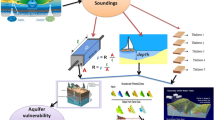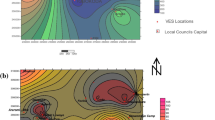Abstract
This study was carried out employing vertical electrical sounding (VES) and electrical resistivity tomography (ERT) with the objective of evaluating the groundwater potential and vulnerability. The study involves a total of seven VES and three ERT profiles employing Schlumberger and Wenner electrodes’ configuration, respectively. The data were analyzed both manually and with WinResist and RES2DINV software packages. The results revealed the variation of resistivity across the study area within the maximum current penetration. The aquifer resistivity and thickness range from 6.2 to 204.2 Ω m and 18.2 to 56.4 m, respectively. The estimated parameters (longitudinal conductance, transverse resistance, hydraulic conductivity, and transmissivity) range: 0.003–0.02 Ω−1, 141.68–575.77 Ω m2, 2.71–70.45 m/day, and 49.23–3973.28 m2/day, respectively. It was observed that the groundwater potential is good in the study area and the protective capacity determine from the estimated longitudinal conductance showed poor protective capacity across the study area, indicating high vulnerability. The poor protective capacity renders the aquifer vulnerable to contamination and this is a major threat to groundwater in the study area.














Similar content being viewed by others
References
Aleke CG, Okogbue CO, Aghamelu OP, Nnaji NJ (2016) Hydrogeological potential and qualitative assessment of groundwater from the Ajali Sandstone at Ninth mile area, southeastern Nigeria. Environ Earth Sci 75:290
Aleke CG, Ibuot JC, Obiora DN (2018) Application of electrical resistivity method in estimating geohydraulic properties of a sandy hydrolithofacies: a case study of Ajali Sandstone in Ninth Mile, Enugu State, Nigeria. Arab J Geosci 11:322
Al-Khafaji WM, Al-Dabbagh HA (2016) Visualizing geoelectric-hydrogeological parameters of Fadak farm at Najaf Ashraf by using 2D spatial interpolation methods. NRIAG J Astron Geophys 5:313–322
Barker R, Rao TV, Thangarajan M (2001) Delineation of contaminant zone through electrical imaging technique. Curr Sci 81(3):277–283
Ebong DE, Akpan AE, Onwuegbueche AA (2014) Estimation of geohydraulic parameters from fractured shales and sandstone aquifers of Abi (Nigeria) using electrical resistivity and hygeologic measurements. J Afr Earth Sci 96:99 –109
Egesi N (2017) Structural features of Ajali Sandstone in the Western and Eastern parts of River Niger, Southern Nigeria. J Geogr Environ Earth Sci Int 11(2):1–12
Freeze RA, Cheery JA (1979) Groundwater. Prentice-Hall Inc, Englewood Cliffs, p 604
George NJ, Emah JB, Ekong UN (2015) Geohydrodynamic properties of hydrogeological units in parts of Niger Delta, Southern Nigeria. J Afr Earth Sci 105(2015):55–63
George NJ, Ibuot JC, Ekanem AM, George A (2018) Estimating the indices of inter-transmissibility magnitude of active surficial hydrogeologic units in Itu, Akwa Ibom State, Southern Nigeria. Arab J Geosci 11(6):1–16
George NJ, Akpan AE, Ekanem AM (2016) Assessment of textural variation pattern and electrical conduction of economic and accessible quaternary hydrolithofacies via geoelectric and laboratory methods in SE Nigeria: a case study of select locations in AkwaIbom State. J Geol Soc India 88:517–520
Heigold PC, Gilkeson RH, Cartwright K, Reed PC (1979) Aquifer transmissivity from surficial electrical methods. Groundwater 17(4):338–345
Henriet JP (1979) Direct application of Dar Zarrouk parameters in groundwater survey. Geophys Prospect 24:344–353
Hubbard SS, Rubin Y (2005) Introduction to hydrogeophysics. In: Rubin Y, Hubbard SS (eds) hydrogeophysics. Springer, Dordrecht, pp 3–21
Ibuot JC, Okeke FN, George NJ, Obiora DN (2017) Geophysical and Physicochemical characterization of organic waste contamination of hydrolithofacies in the coastal dumpsite of AkwaIbom State, Southern Nigeria. Water Sci Technol Water Supply 17(6):1626–1637
Ibuot JC, George NJ, Okwesili AN, Obiora DN (2019) Investigation of litho-textural characteristics of aquifer in Nkanu West Local Government Area of Enugu state, southeastern Nigeria. J Afr Earth Sci 157(2019):197–2017
Maillet RE (1947) The fundamental equations of electrical prospecting. Geophysics 12:529–556
Niwas S, Singhal DC (1981) Estimation of aquifer transmissivity from Da-Zarrouk parameters in porous media. J Hydrol 50:393–399
Obiora DN, Ajala AE, Ibuot JC (2015) Evaluation of aquifer protective capacity of overburden unit and soil corrosivity in Makurdi, Benue State, Nigeria, using electrical resistivity method. J Earth Syst Sci 124(1):125–135
Offodile ME (1983) The occurrence and exploitation of groundwater in Nigeria basement complex. J Geol Min 20:131–146
Oladapo MI, Mohammed MZ, Adeoye OO, Adetola OO (2004) Geoelectric investigation of the Ondo State Housing Corporation Estate; Ijapo, Akure, Southwestern Nigeria. J Min Geol 40:41–48
Orellana E, Mooney H (1966) Master tables and curves for VES over layered structures. Interciencia, Madrid
Soupious P, Papadopoulos I, Kouli M, Georgaki I, Vallianatos F, Kokkinou E (2007) Investigation of waste disposal areas using electrical methods: a case study from Chania, Crete, Greece. Environ Geol 51(7):1249–1261
Stow DAV (2005) Sedimentary rocks in the field: a colour guide. Mason Publ. Ltd., London, p 320
Utom AU, Odoh BI, Okoro AU (2012) Estimation of Aquifer Transmissivity using Dar-Zarrouk parameters derived from surface resistivity measurements: a case history from parts of Enugu Town (Nigeria). J Water Resour Prot 4:993–1000
Uzoije AP, Onunkwo AA, Ibeneme SI, Obioha EY (2014) Hydrogeology of Nsukka South-east—a preliminary approach to water resources development. Am J Eng Res 3(1):150–162
Van Stempvoort DV, Ewert L, Wassenaar L (2013) Aquifer vulnerability index: a gis—compatible method for groundwater vulnerability mapping. Can Water Resour J Revue canadienne des ressources hydriques 18(1):25–37
Wijesekara HR, De Silva SN, Wijesekara DTD, Basnayake A, Vithanage MS (2014) Leachate plume delineation and lithologic profiling using surface resistivity in an open municipal solid waste dumpsite, Sri Lanka. Environ Technol 2914:1–8
Zohdy AAR, Eaton GP, Mabey DR (1974) Application of surface geophysics to groundwater investigation. USGS techniques of water resources investigations. U. S. Geological Survey, Virginia (book 2, Chapter D1)
Acknowledgements
Authors are grateful to the Tertiary Education Trust Fund (TETFUND), who financed the project through research grant.
Author information
Authors and Affiliations
Corresponding author
Additional information
Publisher's Note
Springer Nature remains neutral with regard to jurisdictional claims in published maps and institutional affiliations.
Rights and permissions
About this article
Cite this article
Oguama, B.E., Ibuot, J.C., Obiora, D.N. et al. Geophysical investigation of groundwater potential, aquifer parameters, and vulnerability: a case study of Enugu State College of Education (Technical). Model. Earth Syst. Environ. 5, 1123–1133 (2019). https://doi.org/10.1007/s40808-019-00595-x
Received:
Accepted:
Published:
Issue Date:
DOI: https://doi.org/10.1007/s40808-019-00595-x




